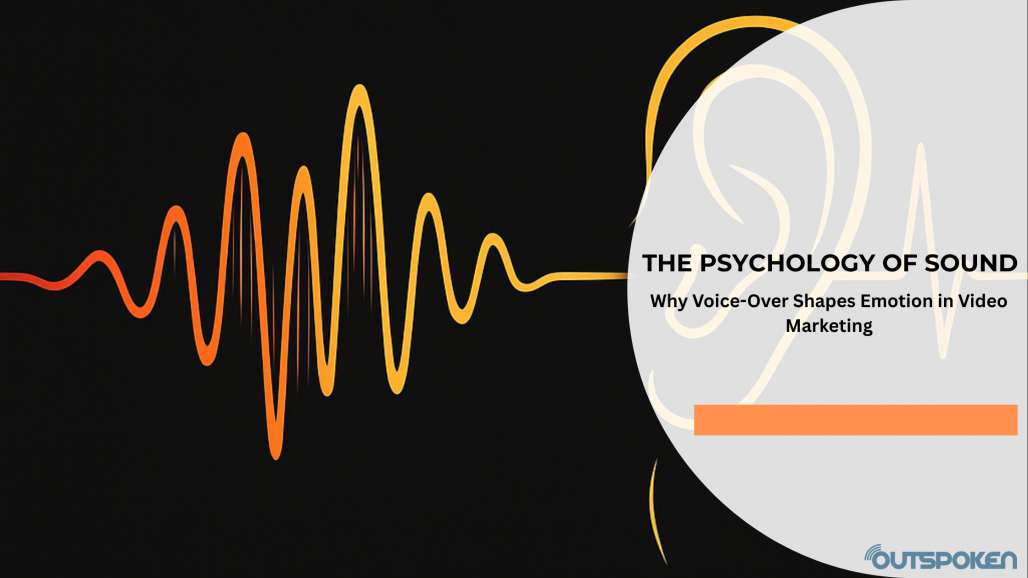Simplify voice-over casting during peak production season. From sharper briefs to curated rosters an...
The Psychology of Sound. Why Voice-Over Shapes Emotion in Video Marketing

Let's talk about something we all pretend doesn't affect us but absolutely does: the voice in the advert. That soothing baritone selling luxury cars, or the conspiratorial whisper promising you'll finally understand cryptocurrency (you won't). Here's the uncomfortable truth: voice-over is more than just creative flourishing; it's neuroscience in action.
In this article, we’ll walk you through why the perfect voice-over shapes emotion in video marketing. Let’s dive in!
The Neuroscience of Voice: Why Your Brain Can't Help But Listen
Voice-over marketing isn't some creative flourish; it's a direct line to the limbic system, that delightfully primitive part of the brain that makes decisions before rational thought has even put its trousers on.
Research in auditory neuroscience shows that the human brain processes vocal tone and inflexion in milliseconds, far faster than visual information. When audiences hear a voice in a video, the amygdala, the bit responsible for emotional processing, lights up like a Christmas tree. This is why emotional marketing through voice works so devastatingly well.
The psychology of sound in marketing leverages a remarkable phenomenon: humans are hardwired to respond to voices. It's evolutionary. For thousands of years, vocal tone indicated friend or foe, safety or danger. Modern video marketing strategies weaponise this ancient instinct with better microphones.
Tone, Tempo, and Timbre: The Holy Trinity of Voice-Over Psychology
The voice-over techniques that make consumers reach for their wallets break down into three key elements:
Tone: The Emotional Architect
Tone of voice in advertising is everything. A warm, friendly tone activates the brain's trust centres, the same ones that respond to a loved one's voice. This is why brands selling "wellness" or "community" always sound like they're about to offer a cup of tea.
Conversely, an authoritative tone triggers respect and attention. It's the same psychological mechanism that made students sit up straighter when the headteacher walked past. Professional voice-over artists understand this instinctively, modulating their delivery to match the brand’s voice psychology and tone.
Tempo: The Pace of Persuasion
Speed matters more than expected in audio branding. Slow, measured delivery suggests gravitas and importance, perfect for luxury goods or serious messaging. Fast-paced delivery creates urgency and excitement, ideal for limited-time offers or youth-oriented products.
The psychology of voice in video content shows that tempo also affects memory retention. Moderate pacing allows the brain time to process information without feeling rushed, which is why the best explainer video voice-overs never sound like they're reading terms and conditions.
Timbre: The Texture of Trust
Timbre, the unique quality of a voice, is where the real magic happens in voice-over emotional impact. Deep voices are associated with authority and trustworthiness (even when they probably shouldn't be). Higher voices can convey energy and approachability.
This is why casting the right voice talent can make or break a campaign. The wrong timbre creates cognitive dissonance, the brain simply doesn't believe what it's hearing, regardless of how brilliant the script is.
The Mirror Neuron Effect: Why We Feel What We Hear
The neuroscience of voice-over reveals something properly clever. Mirror neurons, those little brain cells that make people yawn when someone else yawns, also fire when audiences hear emotion in a voice.
When a voice actor delivers a line with genuine warmth, mirror neurons activate the same emotional state in the listener's brain. Audiences literally feel what performers are conveying. This is the neurological foundation of emotional storytelling in marketing and why authentic delivery beats technically perfect but soulless voice-over (e.g. AI voices) every single time.
Voice-over persuasion techniques that leverage this include:
- Strategic pauses that create anticipation
- Vocal emphasis that highlights key benefits
- Emotional inflexion that mirrors the viewer's desired state
Accent, Dialect, and the Geography of Trust
The impact of voice on consumer behaviour varies wildly depending on accent. British accents may suggest sophistication and intelligence. American accents can convey confidence and innovation. Regional accents usually create intimacy and relatability.
Smart video content optimisation considers the target audience's accent preferences. A Geordie voice-over might be perfect for a local campaign in Newcastle, but could confuse audiences in Singapore. This is audio psychology meets market research, and when executed correctly, conversion rates genuinely improve.
The Silence Between: Why Pauses Matter More Than Words
Professional voice-over artists know that silence is a tool, not an absence. Strategic pauses in marketing videos with voice-over allow the brain to process information, create dramatic tension, and emphasise key points.
The psychology of sound design shows that silence increases anticipation, which activates the brain's reward centres when the voice returns. It's Pavlovian, really; audiences are conditioned to respond to the pattern.
Gender, Age, and Voice: The Demographics of Persuasion
The data on voice characteristics in advertising is fascinating and occasionally depressing. Male voices are still disproportionately used for "serious" products like cars and finance, while female voices dominate healthcare and family-oriented products. This reflects societal biases but also shows how deeply voice psychology is embedded in cultural expectations.
Age matters too. Younger voices suggest innovation and energy, perfect for tech products. Mature voices convey experience and reliability, ideal for healthcare or financial services. The best voice-over for brand storytelling aligns vocal demographics with target audience expectations, avoiding crass stereotypes.
Practical Applications: How to Choose Voice-Over That Actually Works
Years of industry experience reveal these truths about effective voice-over marketing:
- Match voice to brand values, not trends. Authenticity beats trendiness every time in audio content marketing.
- Test with real audiences. Data beats opinions in video marketing psychology.
- Invest in professional talent. AI voices are improving, but human nuance still wins for emotional connection in marketing.
- Consider the entire sonic landscape. Voice-over doesn't exist in isolation; it's part of sound design in video marketing.
- Remember accessibility. Ensure voice-over content strategy includes considerations for hearing-impaired audiences.
The Future: Where Voice-Over Psychology Is Heading
As video marketing trends evolve, so does the understanding of auditory persuasion. Spatial audio, personalised voice content, and AI-generated voices are changing the landscape, but the fundamental psychology of sound in advertising remains constant: audiences respond to voices that feel human, authentic, and emotionally resonant.
Brands that understand the impact of voice-over on engagement will continue to dominate because they're speaking to something primal, that ancient need to hear a voice and know whether to trust it.
The Bottom Line
Voice-over in video marketing isn't decoration; it's neurological warfare (the friendly kind). When done well, it bypasses rational thinking and speaks directly to emotion, trust, and desire. When done poorly, it's just expensive noise.
The power of voice in marketing lies in its ability to make viewers feel before they think. And in an attention economy where brands have about three seconds to make an impact, that emotional shortcut is worth its weight in production gold.
So next time that inexplicable draw to a product happens because an advert "just felt right," check the voice-over. Chances are, someone who understands the psychology of sound just executed perfect persuasion, and the audience didn't mind a bit.
Other Articles You Might Like
The Role of Accents in Voice Acting
Newsletter
Stay up to date with news and special offers. Get to know our new actors and features
NEED HELP?
Visit Frequently Asked Questions page or send us a question.











.png)











Comment